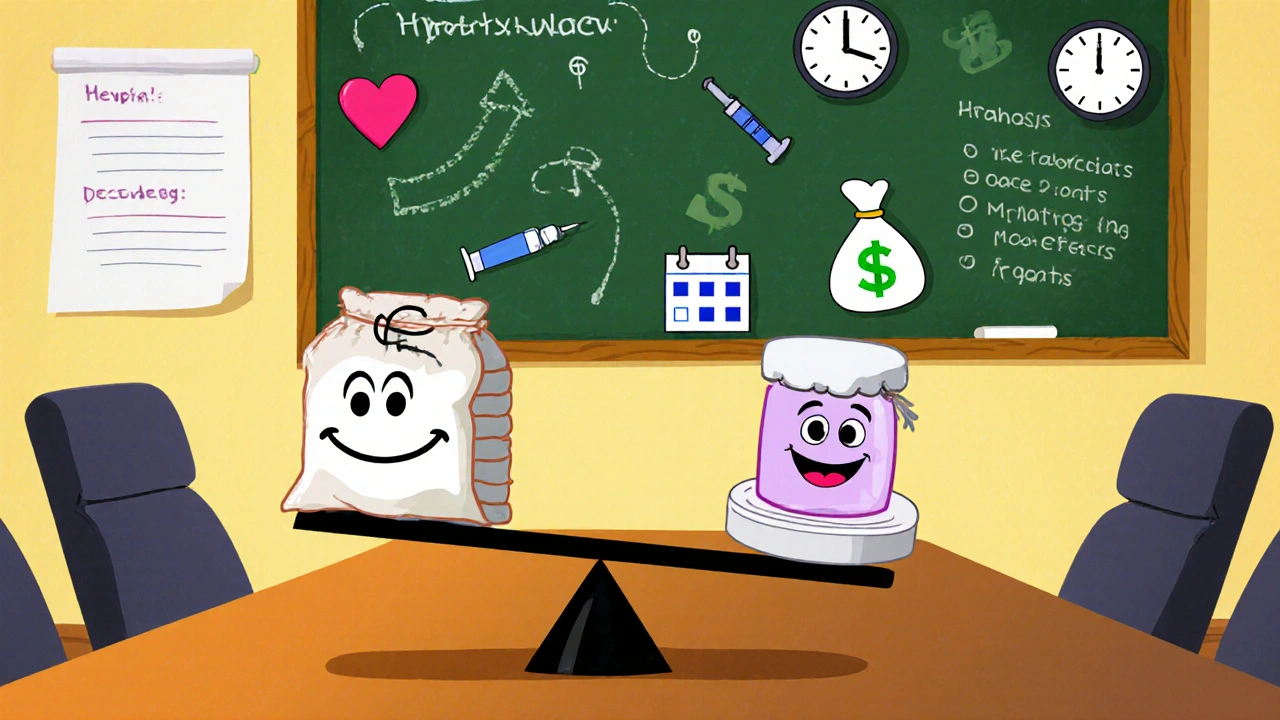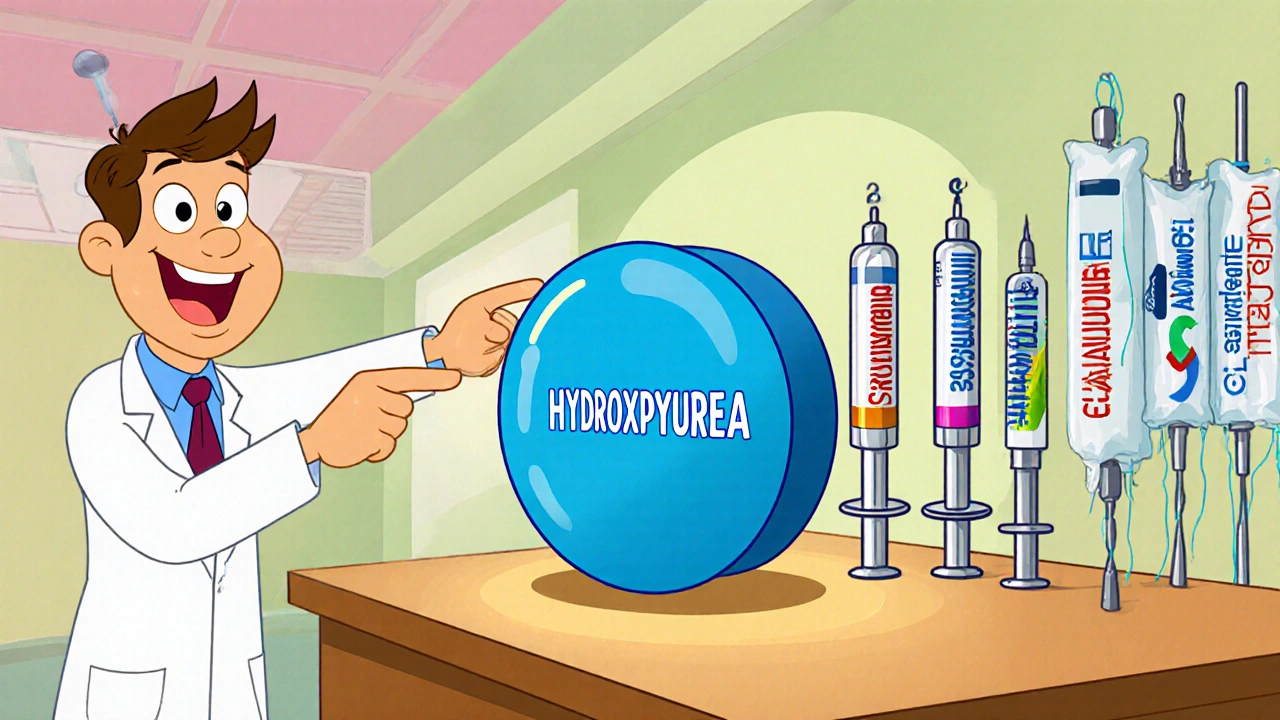Therapy Comparison Tool
Select your condition
Sickle Cell Disease
For patients with frequent pain crises or acute chest syndrome
Polycythemia Vera
For patients needing blood cell reduction
Essential Thrombocythemia
For patients with high platelet counts
Chronic Myeloid Leukemia
For patients needing cytoreduction
Select your priority factors
Cost
Affordability and insurance coverage
Administration
How treatment is delivered
Side Effects
Tolerability of adverse effects
Effectiveness
Reduction in symptoms and complications
Monitoring Burden
Frequency of tests and visits
Long-Term Data
Available evidence and safety profile
Your therapy recommendations
Recommended Therapy
Pros:
Cons:
When treating blood‑related disorders, Hydroxyurea is a cornerstone medication. It is sold under the brand name Hydrea and works by inhibiting ribonucleotide reductase, which slows down DNA synthesis in rapidly dividing cells. The drug has been approved for sickle cell disease, certain leukemias, and some myeloproliferative neoplasms.
Key Takeaways
- Hydroxyurea reduces sickle cell crises by raising fetal hemoglobin levels.
- Newer biologics (e.g., crizanlizumab) target blood vessel adhesion instead of DNA synthesis.
- Choice of therapy hinges on disease type, side‑effect tolerance, administration route, and cost.
- Most alternatives are administered intravenously or subcutaneously, whereas hydroxyurea is an oral tablet.
- Regular lab monitoring is essential for every option, but the frequency and parameters differ.
How Hydroxyurea Works
Hydroxyurea blocks the enzyme ribonucleotide reductase, curbing the production of deoxyribonucleotides needed for DNA replication. In sickle cell disease, this pause forces the bone marrow to produce more fetal hemoglobin (HbF). Higher HbF dilutes the sickle hemoglobin (HbS), decreasing polymerization and thus reducing painful crises.
In myeloproliferative neoplasms such as polycythemia vera, the drug tempers excess blood cell production, lowering the risk of thrombosis. For chronic myeloid leukemia (CML) in the chronic phase, hydroxyurea can provide short‑term cytoreduction while awaiting targeted therapy.
When Hydroxyurea Is Typically Used
- Sickle cell disease (SCD): patients with ≥3 pain crises per year or a history of acute chest syndrome.
- Polycythemia vera (PV): as a second‑line agent when phlebotomy alone is insufficient.
- Essential thrombocythemia (ET): to lower platelet counts in high‑risk patients.
- Chronic myeloid leukemia (CML): bridging therapy while awaiting tyrosine‑kinase inhibitor (TKI) response.

Major Alternatives Across Indications
Below are the most common alternatives, grouped by the condition they treat.
| Drug (Entity) | Primary Indication | Mechanism | Administration | Key Benefits | Common Side Effects |
|---|---|---|---|---|---|
| Hydroxyurea | Sickle cell disease, PV, ET, CML | Ribonucleotide reductase inhibition → ↑ fetal Hb, ↓ cell proliferation | Oral tablets (daily) | Proven mortality benefit in SCD, inexpensive, oral dosing | Myelosuppression, leg ulcers, renal dysfunction |
| L‑glutamine | Sickle cell disease | Reduces oxidative stress in red cells | Oral powder (twice daily) | Modest reduction in pain episodes, well‑tolerated | Gastrointestinal upset, nausea |
| Crizanlizumab | Sickle cell disease | Monoclonal antibody against P‑selectin → blocks vaso‑occlusion | IV infusion (once monthly) | Significant drop in vaso‑occlusive crises for high‑risk patients | Infusion reactions, headache, nausea |
| Voxelotor | Sickle cell disease | HbS‑oxygen affinity enhancer → inhibits polymerization | Oral tablets (once daily) | Improves hemoglobin levels, reduces hemolysis | Liver enzyme elevation, headache |
| Imatinib | Chronic myeloid leukemia | Tyrosine‑kinase inhibitor targeting BCR‑ABL | Oral tablets (once daily) | High long‑term remission rates, targeted action | Fluid retention, muscle cramps, rash |
| Busulfan | Chronic myeloid leukemia (pre‑TKI era) | Alkylating agent → cross‑links DNA | Oral or IV (depends on formulation) | Potent cytoreduction when rapid control needed | Pulmonary fibrosis, marrow suppression |
| Interferon‑alpha | Polycythemia vera, essential thrombocythemia | Immunomodulation → reduces clonal proliferation | Subcutaneous injection (3‑times weekly) | Can induce molecular remission, favorable side‑effect profile versus hydroxyurea in some | Flu‑like symptoms, depression, liver enzyme rise |
| Ruxolitinib | Myelofibrosis, polycythemia vera (post‑hydroxyurea) | JAK1/2 inhibitor → reduces cytokine signaling | Oral tablets (twice daily) | Improves splenomegaly, constitutional symptoms | Anemia, thrombocytopenia, infections |
Pros and Cons: Hydroxyurea vs Each Alternative
Hydroxyurea vs L‑glutamine: Both are oral, but hydroxyurea’s impact on HbF is far stronger, translating to a larger drop in crisis frequency. L‑glutamine’s side‑effect burden is lighter, making it a good add‑on or first‑line for patients who can’t tolerate myelosuppression.
Hydroxyurea vs Crizanlizumab: Crizanlizumab offers a dramatic reduction in vaso‑occlusive events for high‑risk patients, yet it requires monthly infusions and is considerably pricier. Hydroxyurea remains the go‑to for most patients because of cost and the convenience of a daily pill.
Hydroxyurea vs Voxelotor: Voxelotor raises hemoglobin and reduces hemolysis without suppressing bone marrow, which appeals to patients with baseline cytopenias. However, hydroxyurea’s long‑track record in preventing stroke and organ damage still makes it the default in many guidelines.
Hydroxyurea vs Imatinib (CML context): Imatinib directly targets the BCR‑ABL fusion protein, delivering deep molecular remission in >80% of patients. Hydroxyurea is only a bridge therapy; it does not induce durable remission.
Hydroxyurea vs Busulfan: Busulfan is far more toxic, especially for long‑term use, but can achieve rapid cytoreduction when an urgent drop in leukocyte count is needed. Hydroxyurea is safer for chronic management.
Hydroxyurea vs Interferon‑alpha: Interferon offers a chance at molecular remission in PV/ET and avoids the risk of leg ulcers. Its subcutaneous route and flu‑like side effects limit uptake.
Hydroxyurea vs Ruxolitinib: Ruxolitinib excels at controlling splenomegaly and constitutional symptoms in myelofibrosis, but it can worsen anemia-something hydroxyurea already risks. Ruxolitinib is usually reserved for patients who have progressed beyond hydroxyurea.

Decision Factors to Weigh
- Disease indication: Not all alternatives cover the same condition. Choose the drug that matches the diagnosis.
- Administration preference: Oral tablets (hydroxyurea, L‑glutamine, voxelotor, imatinib) versus injections/infusions (crizanlizumab, interferon‑alpha).
- Side‑effect tolerance: Myelosuppression may be unacceptable for patients with baseline low counts; in that case, voxelotor or interferon may be better.
- Cost & insurance coverage: Hydroxyurea is generic and inexpensive. Biologics like crizanlizumab can cost >$30,000 per year.
- Monitoring burden: Hydroxyurea requires CBC every 2‑4 weeks initially, then every 8‑12 weeks. Ruxolitinib needs liver function tests and CBC more frequently.
- Long‑term outcome data: Hydroxyurea has >30years of survival data in SCD; newer agents have shorter follow‑up.
Practical Checklist for Patients and Clinicians
- Confirm the exact diagnosis and disease stage.
- Review baseline labs: CBC, renal & hepatic panels, fetal Hb percentage (if SCD).
- Discuss administration logistics (pill vs infusion).
- Compare out‑of‑pocket costs; ask pharmacy about subsidies.
- Set a monitoring schedule tailored to the chosen drug.
- Re‑evaluate efficacy every 3‑6 months: crisis frequency, hemoglobin level, spleen size, leukocyte count.
- Document any adverse events promptly; adjust dose or switch if toxicity emerges.
Frequently Asked Questions
Can I take hydroxyurea and crizanlizumab together?
Yes, many clinicians combine the two for patients with frequent crises who still need the HbF boost from hydroxyurea. The combo can further lower pain episodes, but it requires close monitoring for myelosuppression.
Is hydroxyurea safe during pregnancy?
Hydroxyurea is classified as a Category D drug; it can cause fetal harm. Women of childbearing potential should use effective contraception and discuss alternatives with their hematologist before trying to conceive.
What monitoring is required for voxelotor?
Baseline liver enzymes and hemoglobin are needed, followed by checks every 12 weeks. Unlike hydroxyurea, voxelotor does not cause neutropenia, so CBC frequency is lower.
Why would a doctor choose interferon over hydroxyurea for polycythemia vera?
Interferon can induce molecular remission and avoids the risk of leg ulcers or secondary malignancies linked to long‑term hydroxyurea use. It’s preferred for younger patients or those who cannot tolerate cytopenias.
Is there a generic version of crizanlizumab?
No, crizanlizumab is a biologic still under patent, so only the brand formulation (Adakveo) is available, making it expensive.







Dean Marrinan
October 15, 2025 AT 20:08Wow, another endless table of drug names – just what the world needed! 🙄 If you love scrolling through spreadsheets, grab a coffee and enjoy the hydroxyurea saga. It's cheap, oral, and apparently the superhero of sickle‑cell care, but don't forget the leg ulcers that love to crash your party. 🌈 Remember, the cheaper pill may still demand the most frequent blood draws – a delightful combo for the budget‑conscious. So choose wisely, or just keep flipping pages like a true pharma‑enthusiast.
Oluseyi Anani
October 29, 2025 AT 09:32Let’s be crystal clear: the hierarchy of evidence still crowns hydroxyurea as the gold standard for sickle‑cell disease, thanks to decades of data and mortality benefit. Alternatives like crizanlizumab or voxelotor are promising, yet they cannot replace the proven HbF‑boosting power of Hydroxyurea. Ethically, we should reserve the pricey biologics for patients who truly cannot tolerate myelosuppression. In practice, a thoughtful risk‑benefit discussion is the only moral path forward.
Rahul yadav
November 11, 2025 AT 23:56Reading through that comparison feels like watching a drama unfold on a hospital stage. 🎭 The oral convenience of Hydroxyurea juxtaposed with the high‑tech infusion of crizanlizumab is a classic case of “old school vs. new school.” I totally get the frustration of frequent labs – they're the unsung side‑kicks that nobody loves. Hang in there, fellow warriors; every pill and drip is a step toward better days. 😊
Ryan Pitt
November 25, 2025 AT 14:20Hydroxyurea is a solid first‑line choice; keep monitoring labs and stay hopeful. You’ve got this!
Jami Johnson
December 9, 2025 AT 04:44The tapestry of hematologic therapeutics is woven with threads of hope, desperation, and the relentless march of science, each drug a distinct hue in an ever‑expanding palette. Hydroxyurea, that unassuming oral tablet, has long stood as a bastion against the ravages of sickle‑cell disease, its legacy forged in the crucible of three decades of rigorous study and undeniable mortality benefit. Yet, as the sunrise of novel biologics pierces the horizon, clinicians find themselves at a crossroads, balancing the familiar comfort of a cheap, well‑characterized agent against the seductive promise of targeted mechanisms. Crizanlizumab, the monoclonal antibody that blocks P‑selectin, offers a dramatic reduction in vaso‑occlusive crises, but demands monthly infusions that tether patients to infusion centers and inflate the cost ledger beyond the reach of many. Voxelotor, by reshaping hemoglobin affinity, lifts hemoglobin levels without the marrow suppression that haunts hydroxyurea, yet its long‑term impact on organ protection remains an uncharted sea. L‑glutamine, a modest amino‑acid supplement, whispers of modest benefit with a tolerable side‑effect profile, perhaps serving as an adjunct rather than a replacement. Interferon‑alpha, with its subcutaneous sting, beckons the younger, more resilient patient toward molecular remission, though the flu‑like malaise it brings can be a cruel companion. Ruxolitinib, a JAK inhibitor, steadies the splenomegaly and constitutional turmoil of myelofibrosis, yet its myelosuppressive shadows echo the very concerns that hydroxyurea sought to mitigate. The decision matrix, therefore, is not a simple algorithm but a nuanced dialogue between physician and patient, weighing disease phenotype, comorbidities, financial constraints, and personal preferences. Regular CBC monitoring, liver function tests, and vigilant assessment of ulcerative skin lesions become the rhythm of care, a metronome that guides therapeutic adjustments. In the theater of chronic disease, adherence is the unsung hero, for even the most sophisticated drug falters if not taken as prescribed. Thus, the clinician must don the hat of counselor, educator, and sometimes even advocate, navigating insurance labyrinths to secure the most equitable access. The ultimate goal, beyond the pharmacologic jargon, is to restore quality of life, to see children run without pain, adults work without fatigue, and families cherish moments unshadowed by crisis. As we stand at this juncture, let us remember that science is not a rigid edifice but a living, breathing conversation, ever‑evolving with each trial, each patient story, each whispered hope. May our choices reflect both wisdom of the past and courage to embrace the future.